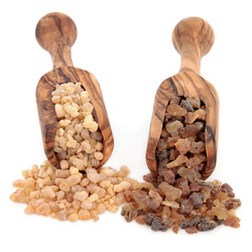 These two items show up all over the place in Christmas music. This verse from the modern carol “In the Silence” by Craig Courtney with words incorporating an Appalachian folk song is particularly pointed, as it includes the symbolism quite plainly:
These two items show up all over the place in Christmas music. This verse from the modern carol “In the Silence” by Craig Courtney with words incorporating an Appalachian folk song is particularly pointed, as it includes the symbolism quite plainly:
Why a gift for tombs they brought on this, the Savior’s birth?
I think we all have a vague idea that the two exotic items of frankincense and myrrh have something to do with perfume or incense, but that’s probably about it.
There are some very interesting biblical associations with these substances, the most obvious being that they were used for the incense burned in Israel’s tabernacle and later temple. Even more fitting, perhaps, is that both of these fragrances are only obtained when the trees that produce them are wounded; the process of slashing the bark so that the resins will ooze out is often called “bleeding the trees.” So they can be seen as symbols of suffering as well as of worship. Christians believe that the book of Isaiah in the Jewish Bible, chapter 53, gives a similar picture of the suffering Messiah:
Surely he took up our pain and bore our suffering, yet we considered him punished by God, stricken by him, and afflicted. But he was pierced for our transgressions, he was crushed for our iniquities; the punishment that brought us peace was on him, and by his wounds we are healed. We all, like sheep, have gone astray, each of us has turned to our own way; and the Lord has laid on him the iniquity of us all.
As you look at, listen or sing the words to many traditional carols you’ll see the idea of Christ’s coming to set men free from sin occurring over and over. There’s great joy in the present but great sorrow to come, and this theme is carried out even in the rich offerings from these exotic and mysterious visitors.
So what did Mary and Joseph do with the gifts of the Magi? We don’t really know. There is one possibility, though, that makes a lot of sense: the gold, at least, but possibly the other two items, were used to finance the trip to Egypt that they made in order to escape Herod’s killing of all children under the age of two in order to get rid of the “King of the Jews” that the Magi had talked about. (The fact that Herod is going after toddlers and not just babies is another clue that tells us we’re not dealing with the birth of Christ here.) How else could they have made the journey? The Magi had no idea of all this as they opened their treasures and made their offerings. They did what they had come to do and left, vanishing from the record. Surely we can at least honor them by remembering their journey and sacrifice as we see the rows of “frankincense and myrrh” candles at the store!
Since I referenced a specific song in this post I wanted to include a video, which wasn’t easy to find. However, lo and behold, here’s a very recent virtual choir performance that’s pretty good!
© Debi Simons

